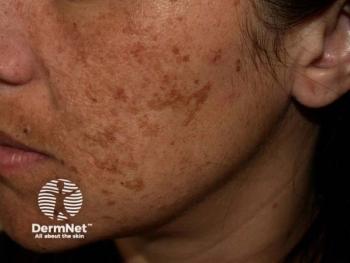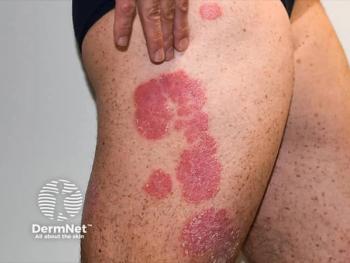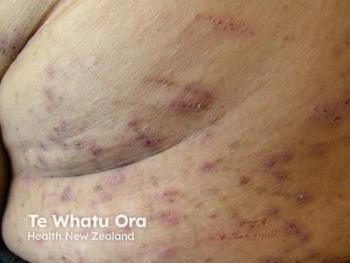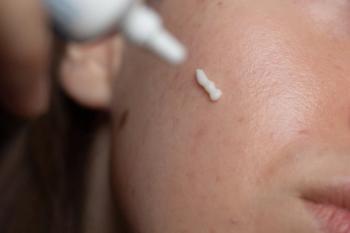
- Dermatology Times, July 2025 (Vol. 46. No. 07)
- Volume 46
- Issue 07
FDA News and Decisions: Midyear Updates
Key Takeaways
- Fesarius Therapeutics' DermiSphere hydrogel received FDA clearance for advanced wound care, supporting tissue integration and revascularization.
- Dupilumab was approved for chronic spontaneous urticaria, marking the first new targeted therapy for CSU in over a decade.
Exclusive Report: A comprehensive look at the latest FDA approvals and pipeline developments in dermatology from the first half of 2025.
The first half of 2025 brought about numerous developments in dermatology, with key decisions from the FDA and a surge of activity across submissions, trial advancements, and regulatory actions driving the pipeline forward. To help you stay informed, we compiled an overview of FDA approvals and clearances, new filings, and other pivotal regulatory movements in the specialty from January through June.
FDA Approvals and Clearances
Collagen-Based DermiSphere Hydrogel
January: Fesarius Therapeutics Inc was granted 510(k) clearance for its DermiSphere hydrogel Dermal Regeneration Template (DermiSphere hDRT).1 The collagen-based dermal matrix is engineered to support tissue integration, revascularization, and wound healing, making it suitable for advanced wound care, reconstructive surgery, and regenerative medicine. The agent features a hydrogel composition that closely mimics the extracellular matrix, enhancing cellular infiltration and tissue regeneration.
Dupilumab for H1 Antihistamine-Refractory CSU
April: Dupilumab (Dupixent; Sanofi and Regeneron) received approval for the treatment of chronic spontaneous urticaria (CSU) in patients aged 12 years and older whose symptoms remain uncontrolled with H1 antihistamines.2 This marks the first new targeted CSU therapy for patients in over a decade. In the pivotal phase 3 LIBERTY-CSU CUPID trial (NCT04180488), especially Study C, dupilumab showed significant improvements in symptom control, with nearly half of biologic-naive patients achieving well-controlled disease.
Pz-cel for RDEB
April: The FDA approved prademagene zamikeracel, also known as pz-cel (Zevaskyn; Abeona Therapeutics Inc), marking the first autologous, gene-corrected cell therapy for recessive dystrophic epidermolysis bullosa.3 The agency based its landmark approval on data from the phase 3 VIITAL trial and a phase 1/2a study, which demonstrated significant and durable wound closure following a single application, with some patients experiencing benefits lasting up to 8 years.
LED BLU-U Device for AK
May: Sun Pharmaceutical Industries Limited received premarket approval for its next-generation BLU-U Blue Light Photodynamic Therapy Illuminator.4 The updated device replaces the original fluorescent tube design with modern LED panels. It is approved for use alongside Levulan Kerastic topical solution, 20%, (aminolevulinic acid HCl) , to treat minimally to moderately thick actinic keratoses on the face, scalp, and upper extremities.
Roflumilast Foam for Plaque Psoriasis
May: Arcutis Biotherapeutics’ Zoryve (roflumilast) foam 0.3% was granted approval for the treatment of plaque psoriasis on the scalp and body in patients aged 12 years and older.5 The steroid-free, once-daily foam formulation offers a convenient option for treating hard-to-reach, hair-bearing areas where traditional creams or ointments may be difficult to apply. Clinical trial data showed that roflumilast foam delivered rapid itch relief and significant plaque clearance, with no restrictions on duration of use.
Dupilumab for Bullous Pemphigoid
June: Regeneron and Sanofi's dupilumab (Dupixent) was granted approval as the first targeted treatment for adults with bullous pemphigoid, offering an advancement over traditional therapies like steroids and immunosuppressants.6 Backed by strong phase 2/3 data showing improved remission rates, reduced itch, and lower corticosteroid use, dupilumab demonstrated superior efficacy in real-world and comparative studies.
Regulatory Activity
Zabalafin Hydrogel’s IND Application Cleared for AD
February: Alphyn Biologics’ investigational new drug (IND) application for Zabalafin hydrogel received clearance as a novel topical treatment for mild to moderate atopic dermatitis (AD).7 Designed to target inflammation, itch, and bacterial complications, the agent demonstrated promising results in a phase 2a trial. Patients showed notable improvements in symptoms, including itch relief and resolution of skin infections, and the drug had a favorable safety profile.
Rezpegaldesleukin Receives Fast Track Designation for Moderate to Severe AD
February: Rezpegaldesleukin received a fast track designation for the treatment of moderate to severe AD in patients aged 12 years and older whose condition is not adequately managed with topical therapies.8 Nektar Therapeutics’ investigational biologic works by targeting the IL-2 receptor complex to boost regulatory T-cell function and help restore immune balance. In clinical studies, including a 12-week induction phase with follow-up extending 36 weeks post treatment, rezpegaldesleukin demonstrated encouraging improvements in exploratory disease measures.
FDA Accepts SNDA for Roflumilast in Children with AD
February: The FDA accepted Arcutis Biotherapeutics’ supplemental new drug application (SNDA) for Zoryve (roflumilast) cream 0.05% to treat mild to moderate AD in children aged 2 to 5 years.9 The submission was backed by positive data from the INTEGUMENT-PED phase 3 trial (NCT04845620), which showed significant symptom improvements by week 4. The agency has set a target action date of October 13, 2025.
Bempikibart Receives Fast Track Designation for Alopecia Areata
April: Q32 Bio received a fast track designation for its investigational therapy, bempikibart (ADX-914), for the treatment of alopecia areata.10 Bempikibart, a fully human anti–IL-7Rα antibody, works by re-regulating immune function to block IL-7 and TSLP signaling. The fast track status follows encouraging clinical results from the ongoing SIGNAL-AA trial.
References
Fesarius Therapeutics Inc announces FDA 510(k) clearance for DermiSphere hydrogel Dermal Regeneration Template. News release. FesariusTherapeutics Inc. January 8, 2025. Accessed June 4, 2025.
https://www.prnewswire.com/news-releases/fesariustherapeutics-inc-announces-fda-510k-clearance-for-dermisphere-hydrogel-dermal-regeneration-template-302346137.html Dupixent (dupilumab) approved in the US as the first new targeted therapy in over a decade for chronic spontaneous urticaria (CSU). News release. Regeneron Pharmceuticals, Inc. April 18, 2025. Accessed June 4, 2025.
https://www.globenewswire.com/news-release/2025/04/18/3064133/0/en/Dupixent-dupilumab-Approved-in-the-U-S-as-the-First-New-Targeted-Therapy-in-Over-a-Decade-for-Chronic-Spontaneous-Urticaria-CSU.html US FDA approves Zevaskyn (prademagene zamikeracel), the first and only cell-based gene therapy for patients with recessive dystrophic epidermolysis bullosa (RDEB). News release. Abeona Therapeutics Inc. April 29, 2025. Accessed June 4, 2025.
https://investors.abeonatherapeutics.com/press-releases/detail/303/u-s-fda-approves-zevaskyn-prademagene-zamikeracel Sun Pharma announces FDA approval of next-generation BLU-U Blue Light Photodynamic Therapy Illuminator for actinic keratosis. News release. Sun Pharma. May 16, 2025. Accessed June 4, 2025.
https://www.prnewswire.com/news-releases/sun-pharma-announces-fda-approval-of-next-generation-blu-u-blue-light-photodynamic-therapy-illuminator-for-actinic-keratosis-302457770.html Arcutis’ Zoryve (roflumilast) topical foam 0.3% approved by US FDA for the treatment of plaque psoriasis in adults and adolescents ages 12 and older. News release. Arcutis Biotherapeutics Inc. May 22, 2025. Accessed June 4, 2025.
https://www.arcutis.com/arcutis-zoryve-roflumilast-topical-foam-0-3-approved-by-u-s-fda-for-the-treatment-of-plaque-psoriasis-in-adults-and-adolescents-ages-12-and-older/ Dupixent approved in the US as the only targeted medicine to treat patients with bullous pemphigoid. News release. Sanofi. June 20, 2025. Accessed June 20, 2025.
https://www.sanofi.com/en/media-room/press-releases/2025/2025-06-20-05-00-00-3102518 Alphyn secures FDA clearance of investigational new drug application for atopic dermatitis treatment. News release. Alphyn Biologics, Inc. February 19, 2025. Accessed June 4, 2025.
https://www.prnewswire.com/news-releases/alphyn-secures-fda-clearance-of-investigational-new-drug-application-for-atopic-dermatitis-treatment-302379675.html Nektar Therapeutics receives fast track designation for rezpegaldesleukin for the treatment of moderate-to-severe atopic dermatitis. News release. Nektar Therapeutics. February 10, 2025. Accessed June 4, 2025.
https://www.prnewswire.com/news-releases/nektar-therapeutics-receives-fast-track-designation-for-rezpegaldesleukin-for-the-treatment-of-moderate-to-severe-atopic-dermatitis-302371995.html US FDA accepts supplemental new drug application for Arcutis’ Zoryve (roflumilast) cream 0.05% for the treatment of children aged 2 to 5 with mild-to-moderate atopic dermatitis. News release. Arcutis Biotherapeutics, Inc. February 26, 2025. Accessed June 4, 2025.
https://www.arcutis.com/u-s-fda-accepts-supplemental-new-drug-application-for-arcutis-zoryve-roflumilast-cream-0-05-for-the-treatment-of-children-aged-2-to-5-with-mild-to-moderate-atopic-dermatitis/ Q32 Bio announces FDA Fast Track Designation granted to bempikibart (ADX-914) for the treatment of alopecia areata. PR Newswire. April 30, 2025. Accessed June 4, 2025.
https://www.prnewswire.com/news-releases/q32-bio-announces-fda-fast-track-designation-granted-to-bempikibart-adx-914-for-the-treatment-of-alopecia-areata-302441850.html
Articles in this issue
5 months ago
Dermatology Times July 2025 Print Recap5 months ago
Is AI Transforming Skin Care?5 months ago
The Value of RAD, According to Clinicians5 months ago
A New Canvas for Conversations in DermatologyNewsletter
Like what you’re reading? Subscribe to Dermatology Times for weekly updates on therapies, innovations, and real-world practice tips.


















